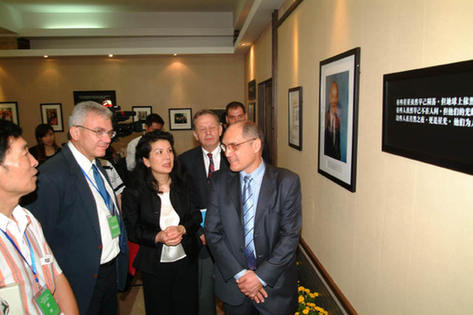Faces of the War
In his memoir My Forty Years as a Diplomat, published in 1990, He wrote about his experiences during this period. He describes how, after Austria’s Anschluss or union with Germany, the plight of Jews worsened as their persecution intensified. He’s account tells of his maintaining close contact with U.S. religious and charitable organizations that helped to save Jewish people, and how he meanwhile did all he could to help and save them.
 |
|
In September 2007, Amos Nadai (first right), then Israeli ambassador to China, visited the Visas for Life exhibition in Hunan Province, which chronicled He Fengshan’s heroic actions. |
He returned to China when the country was embroiled in the War of Resistance against Japan. After retirement in 1973, he settled in San Francisco. During his lifetime, He seldom spoke about his deeds. They became public only after his death in 1997. The obituary his daughter Manli wrote for the Boston Globe included mention of her father issuing visas to Jews. American historian Eric Saul immediately contacted Manli, asking her to elaborate. Saul later searched out Jews who had survived due to the visas He had issued, and also some of their descendants.
He Fengshan’s heroic actions were enshrined at the entrance to the Visas for Life exhibition in Stockholm in January 2000. He is regarded as “China’s Schindler.”
Nie Rongzhen and Kato Mihoko
In 1999, to mark the centenary of renowned Chinese Marshal Nie Rongzhen’s birth, Jiangjin City (now a district of Chongqing), Nie’s hometown, and Kato Mihoko’s hometown, Miyakonojō in Japan, became sister cities. Mihoko said her father’s wish had finally been fulfilled. Her “father” was the eminent Marshal Nie.
On May 28, 1980, China’s national news agency Xinhua published a report titled “Little Japanese Girl, Where Are You?” The story was then reprinted in many domestic newspapers including People’s Daily and PLA Daily. The story tells how soldiers of the Eighth Route Army rescued a Japanese orphan from gunfire during the Great Campaign with One Hundred Regiments (hereafter, Hundred Regiments Campaign) in 1940. Several days after its publication, Japan’s Yomiuri Shimbun traced the little girl of the story to Miyakonojō, Miyazaki. Her name was Kato Mihoko, mother of three girls.
Mihoko’s story started in August, 1940 in a village along the railway line from Shijiazhuang in Hebei Province to Taiyuan in Shanxi Province. It was a vital transportation line crossing the Jingxing Coal Mine, the Japanese army’s fuel base in North China. Mihoko’s father worked at the railway station of the coal mine and was responsible for coal transportation.
The Hundred Regiments Campaign was the largest and longest CPC-led anti-Japanese battle in North China, launched on August 20, 1940. While attacking the Japanese army’s base in the Jingxing mine, Chinese soldiers risked their lives to rescue two girls, one aged four, the other barely one year old, from the flames of war. The two girls were Mihoko and her younger sister. Their parents were both killed in a bombing raid.
Clueless about how to deal with the two little girls, the Chinese soldiers reported to headquarters. Commander Nie Rongzhen sent for the two sisters. Soon, the older girl, Mihoko, formed a bond with Nie, following him wherever he went and often clinging to his trouser legs. A war correspondent captured a group photo of Nie and the little girl outside the command post. This photo became a valuable testimony to the historical moment.
Since Japanese bombings were still rampant around the CPC front command post, for safety’s sake Nie decided to send the two girls back to the Japanese army camp. Nie wrote a letter in person to the Japanese chief commander in Shijiazhuang and entrusted a reliable local farmer to take the girls there. The farmer hoisted the two girls up in baskets on a pole and carried them. Worrying that the girls might act up, Nie filled the baskets with fruit to appease the little travelers. According to Nie Rongzhen’s biography, after receiving the two girls, the Japanese army wrote a letter to Nie expressing their gratitude.
On their arrival at the Japanese base, the two girls were sent to a local hospital. Sadly, due to a severe wound, the younger one died. In October 1940, the older girl, Mihoko, was brought back to Japan by her uncle and went to live with her grandmother. When recalling her experience in China she told her family of sitting in a basket eating pears. These details later formed an important basis for verifying her identity.
